AS Media Studies
Monday, 29 September 2014
Saturday, 27 September 2014
Film Opening - Codes and Conventions
Codes and conventions of a film opening
The Purpose
Toy Story starts with what could be described as an action sequence. There are symbolic codes like a gun and a wild west setting and written code such as the wanted poster. However, the presence of the toys, the voice of the child and an arm and hand makes it very obvious it's a child playing. This is a good introduction to the genre of the movie as it is clearly a kids film. Codes used that help us see this is the symbolic code of all the bright colours and toys plus the written code of the titles which are quite bright and cheerful. The hook for the opening so that people keep watching comes from the excitement of toys that a child would have seeing it and the nostalgia of the adults watching as they might remember doing similar things with their toys as a kid.
Timing conventions
It has a length of 2 and a half minutes which is just a bit longer than the normal 2 minutes however shorter than a lot of more modern blockbusters. It uses the two minutes well to fit in all of the normal movie opening conventions.
Set the Scene
The movie sets the scene well without using an establishing shot which is a technical code that most movies use. The movie uses the symbolic code of a child playing with toys and parts of the interior of the house to give the audience the idea that this is a typical family home. The setting of a family home gives us an idea of the time but also the movie uses certain iconic toys such as Mr potato head and a troll doll to symbolize the time the movie is set, in this case present day (well the 90s when the movie came out).
Introduce main characters
Toy Story introduces multiple characters in it's opening sequence. However, other than Andy, we aren't shown or told that they are actual characters. We are given clues that the toys are characters with things such as woody's entrance, where there is a musical cue that the audience would associate with a triumphant hero, also giving us a clue that he is the main protagonist. Also, during the sequence where Andy is playing with woody downstairs, point of view camera shots are used from woody's perspective. These are all technical codes used to introduce the characters.
Introduce pre-plot or beginning of the narrative
The intro is more of a pre-plot to the movie as the main story-line of the movie (i.e toys being able to talk and the arrival of Buzz) does not start in it. However the them of the narrative (the friendship between toy and owner) is present in the song "you got a friend in me". Also there are clues to the narrative such as the toys talking (see "Introduce main characters").
Key credits
At the beginning there is the iconic Disney castle logo to show it is a Disney. There is also the title of the movie which, while being text, has symbolic colours and design that tells the audience a lot about the film. The rest of the credits are done in written code in a typical credits style saying who worked on the movie. There is a difference between these opening credits and the typical credits you would see though. There is no cast written in the credits. This could be to keep the fact of the toys speaking a mystery till it is actually revealed.
Usually starts with equilibrium
The equilibrium that the movie starts with is Andy playing with all the toys in a action style way and then the mood changes when there is a full shot of the baby and the mood lightens and the theme starts to play.
The Purpose
Toy Story starts with what could be described as an action sequence. There are symbolic codes like a gun and a wild west setting and written code such as the wanted poster. However, the presence of the toys, the voice of the child and an arm and hand makes it very obvious it's a child playing. This is a good introduction to the genre of the movie as it is clearly a kids film. Codes used that help us see this is the symbolic code of all the bright colours and toys plus the written code of the titles which are quite bright and cheerful. The hook for the opening so that people keep watching comes from the excitement of toys that a child would have seeing it and the nostalgia of the adults watching as they might remember doing similar things with their toys as a kid.
Timing conventions
It has a length of 2 and a half minutes which is just a bit longer than the normal 2 minutes however shorter than a lot of more modern blockbusters. It uses the two minutes well to fit in all of the normal movie opening conventions.
Set the Scene
The movie sets the scene well without using an establishing shot which is a technical code that most movies use. The movie uses the symbolic code of a child playing with toys and parts of the interior of the house to give the audience the idea that this is a typical family home. The setting of a family home gives us an idea of the time but also the movie uses certain iconic toys such as Mr potato head and a troll doll to symbolize the time the movie is set, in this case present day (well the 90s when the movie came out).
Introduce main characters
Toy Story introduces multiple characters in it's opening sequence. However, other than Andy, we aren't shown or told that they are actual characters. We are given clues that the toys are characters with things such as woody's entrance, where there is a musical cue that the audience would associate with a triumphant hero, also giving us a clue that he is the main protagonist. Also, during the sequence where Andy is playing with woody downstairs, point of view camera shots are used from woody's perspective. These are all technical codes used to introduce the characters.
Introduce pre-plot or beginning of the narrative
The intro is more of a pre-plot to the movie as the main story-line of the movie (i.e toys being able to talk and the arrival of Buzz) does not start in it. However the them of the narrative (the friendship between toy and owner) is present in the song "you got a friend in me". Also there are clues to the narrative such as the toys talking (see "Introduce main characters").
Key credits
At the beginning there is the iconic Disney castle logo to show it is a Disney. There is also the title of the movie which, while being text, has symbolic colours and design that tells the audience a lot about the film. The rest of the credits are done in written code in a typical credits style saying who worked on the movie. There is a difference between these opening credits and the typical credits you would see though. There is no cast written in the credits. This could be to keep the fact of the toys speaking a mystery till it is actually revealed.
Usually starts with equilibrium
The equilibrium that the movie starts with is Andy playing with all the toys in a action style way and then the mood changes when there is a full shot of the baby and the mood lightens and the theme starts to play.
Monday, 22 September 2014
AS Preliminary Exercise
This is the final edit of my preliminary exercise. I think there are certain parts of both the editing and filming that my group and I did quite well however there are points that we could improve upon. While we were filming we had four members to our group so when there were two people on camera we had one person on camera and another directing the shot. However in one shot of our video the director is visible in the scene. We need to double check our shot before we take it and also take multiple takes of every shot even the ones we thought went well. Also my acting might need improving. In the editing we found it easier because we filmed a few seconds before and after our shots so we were able to find the right points that meant the editing went smoothly. Our main editing problem was we created the editing project in the wrong format. This is why there are large black borders on our video.
Continuity
Continuity is where film is continuous and events are in the correct order. For example, a character in a seen may put flowers down on a table and in the next shot there is nothing on the table. The film is not continuous as the flowers were not seen being moved. Continuity also refers to the order of events in a movie. A movie has to be a correct series of events and not jump around at different times. An example might be a group of people sitting down to eat and suddenly they are eating dessert and in the next shot they are eating the main meal. The order doesn't make sense so there is no continuity.
Thursday, 11 September 2014
Camera Shots
Establishing shot
An establishing shot is a shot that shows the viewer where the scene or movie is set. There will often be certain buildings or landmarks that gives people an idea of the location of a film sometimes it's a specific place and landmarks (like in the example above of an establishing shot in london with big ben in view) or it might just give you an idea of the setting (an example might be a shot of a small village).
Extreme long shot (ELS)

An extreme long shot a shot often used to set the scene or as an establishing shot. It can be taken from up to a quarter of a mile away. It is normally done for an exterior setting like a building or landscape. It is used to show the general details and shows very little specific details. Is also used for shots of large scale action such as views of armies or a disaster movie
Long shot
The long shot can be difficult to precisely categorize. It is generally a shot that shows an entire object or person with a relation to it's or their surroundings. Though the focus is on a object or person there is still detail of the surroundings as well. It can also be used as an establishing shot.
Medium shot
The medium shot is a shot that contains a figure that is shown from the knees or waist up and is primarily used for dialogue or for a closer action shot. There is often very little background detail because of the focus on the characters or action. There are a couple variations of a medium shot. One is when there are two characters shown in the shot talking or involved in action. This is called a "Two shot". When there are three characters shown it is called a "Three shot". There are very rarely ever more than three characters involved in a medium shot.
Close- up
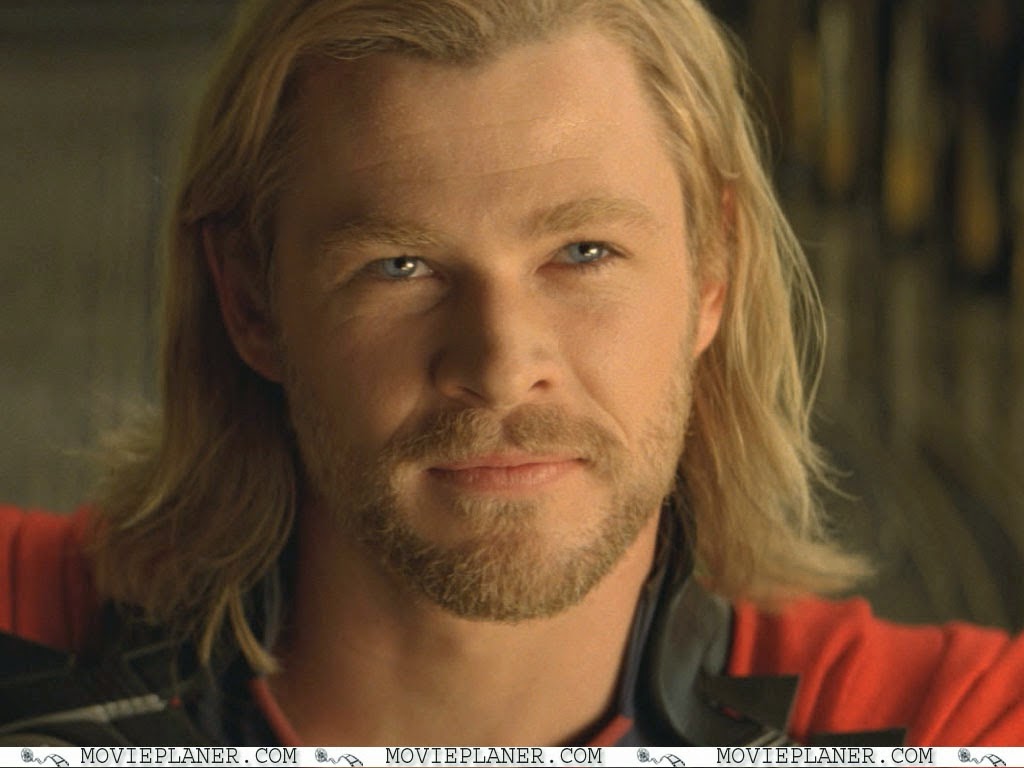
This is a shot that focuses solely on a single subject. This can be a person's face, a specific object or something written on a page. It highlights the importance or significance of the object or text on the page so that the audience pays attention to it. With a person's face it is often used to show the emotions of a character or to give the audience an idea as to what they are thinking.
Extreme close up
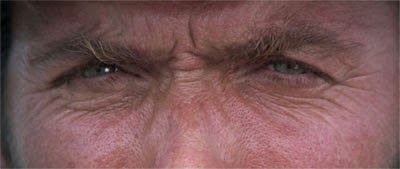
A shot that is magnified to show very specific detail you wouldn't normally observe with the human eye. An extreme close up of a person's face will usually only include the eyes or the mouth. The shot is used for dramatic effect.
Bird's-eye view

A scene viewed from directly above, which is a very strange view of the action which a person would very rarely have. This angle gives the audience a godlike position as they are looking down on the characters and scenery. The subjects of the scene can be made to look insignificant or part of a larger scheme of things.
Point of view shot
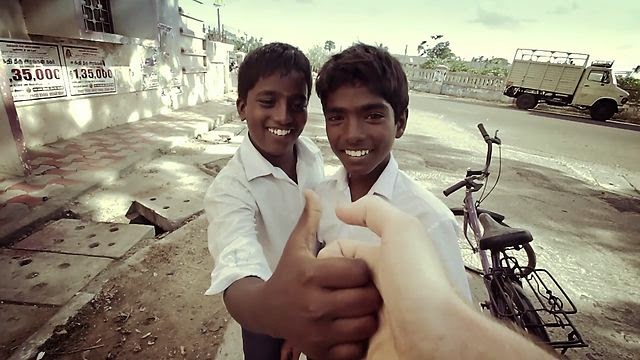
A point of view shot is where the camera is placed so it looks as though we are seeing the action through the characters eyes. Sometimes the character's glasses, hands or limbs will be in shot to establish it is their view point. Other times a close up shot will establish the way a character is looking so the audience can tell that this is that character's view. This shot can help the audience see a character's perspective on certain events are and helps you empathize with their feelings.
Aerial shot
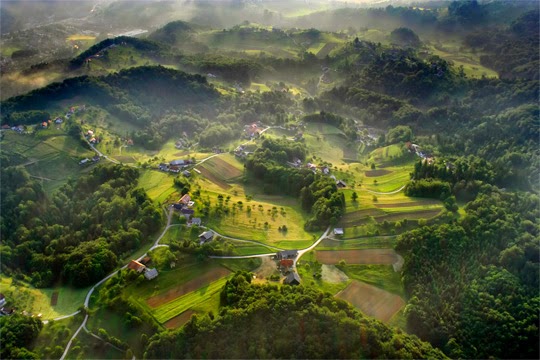
An aerial shot gives a view of the scene from high above. It can be used to set the scene as an establishing shot or to simply give an aerial view of an action sequence.
Over the shoulder
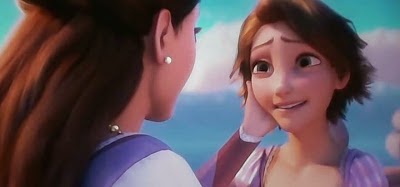
An over the shoulder shot places the camera places the camera behind the shoulder of a character. The audience gets a view of what the character is looking at. It can have a similar effect to a point of view shot but in this shot you can also see part of the character's facial expressions and reactions so it can give more of an idea as to what they are feeling.
An establishing shot is a shot that shows the viewer where the scene or movie is set. There will often be certain buildings or landmarks that gives people an idea of the location of a film sometimes it's a specific place and landmarks (like in the example above of an establishing shot in london with big ben in view) or it might just give you an idea of the setting (an example might be a shot of a small village).
Extreme long shot (ELS)

An extreme long shot a shot often used to set the scene or as an establishing shot. It can be taken from up to a quarter of a mile away. It is normally done for an exterior setting like a building or landscape. It is used to show the general details and shows very little specific details. Is also used for shots of large scale action such as views of armies or a disaster movie
Long shot
The long shot can be difficult to precisely categorize. It is generally a shot that shows an entire object or person with a relation to it's or their surroundings. Though the focus is on a object or person there is still detail of the surroundings as well. It can also be used as an establishing shot.
Medium shot
The medium shot is a shot that contains a figure that is shown from the knees or waist up and is primarily used for dialogue or for a closer action shot. There is often very little background detail because of the focus on the characters or action. There are a couple variations of a medium shot. One is when there are two characters shown in the shot talking or involved in action. This is called a "Two shot". When there are three characters shown it is called a "Three shot". There are very rarely ever more than three characters involved in a medium shot.
Close- up

This is a shot that focuses solely on a single subject. This can be a person's face, a specific object or something written on a page. It highlights the importance or significance of the object or text on the page so that the audience pays attention to it. With a person's face it is often used to show the emotions of a character or to give the audience an idea as to what they are thinking.
Extreme close up

A shot that is magnified to show very specific detail you wouldn't normally observe with the human eye. An extreme close up of a person's face will usually only include the eyes or the mouth. The shot is used for dramatic effect.
Bird's-eye view

A scene viewed from directly above, which is a very strange view of the action which a person would very rarely have. This angle gives the audience a godlike position as they are looking down on the characters and scenery. The subjects of the scene can be made to look insignificant or part of a larger scheme of things.
Point of view shot

A point of view shot is where the camera is placed so it looks as though we are seeing the action through the characters eyes. Sometimes the character's glasses, hands or limbs will be in shot to establish it is their view point. Other times a close up shot will establish the way a character is looking so the audience can tell that this is that character's view. This shot can help the audience see a character's perspective on certain events are and helps you empathize with their feelings.
Aerial shot

An aerial shot gives a view of the scene from high above. It can be used to set the scene as an establishing shot or to simply give an aerial view of an action sequence.
Over the shoulder

An over the shoulder shot places the camera places the camera behind the shoulder of a character. The audience gets a view of what the character is looking at. It can have a similar effect to a point of view shot but in this shot you can also see part of the character's facial expressions and reactions so it can give more of an idea as to what they are feeling.
Monday, 8 September 2014
Production Projects
Brief:
Prelimary:
Produce a continuity exercise which involves a character opening a door, crossing the room and sitting down in a chair opposite another character with whom they exchange a couple of lines of dialouge. The task should demonstrate:
Match on action:
The match on action shot is where the cameraman records the main characters action but from different angles. For example while walking down a hallway a character is being filmed from behind and as they turn a corner the camera angle might switch to the front.
Shot/reverse shot:
Shot reverse shot is a technique in films where one character is shown looking at another character (sometimes off-screen) and then the camera changes to a shot of the second character looking at the first character. The characters are filmed facing opposite directions it makes it seem as if they are talking.
180 degree rule:
The 180 degree rule is when an imaginary line links the two characters and one semi-circle of that line can be filmed from because it keeps the same angle of each character so it seems as if they are always talking to each other. If the camera crosses the imaginary line and goes past 180 degrees then the angles of the faces change and it may appear that both characters are speaking to each other but in the same direction.
Prelimary:
Produce a continuity exercise which involves a character opening a door, crossing the room and sitting down in a chair opposite another character with whom they exchange a couple of lines of dialouge. The task should demonstrate:
Match on action:
The match on action shot is where the cameraman records the main characters action but from different angles. For example while walking down a hallway a character is being filmed from behind and as they turn a corner the camera angle might switch to the front.
Shot/reverse shot:
Shot reverse shot is a technique in films where one character is shown looking at another character (sometimes off-screen) and then the camera changes to a shot of the second character looking at the first character. The characters are filmed facing opposite directions it makes it seem as if they are talking.
180 degree rule:
The 180 degree rule is when an imaginary line links the two characters and one semi-circle of that line can be filmed from because it keeps the same angle of each character so it seems as if they are always talking to each other. If the camera crosses the imaginary line and goes past 180 degrees then the angles of the faces change and it may appear that both characters are speaking to each other but in the same direction.
Me
I am Caleb Warburton and I am 16 years old. I enjoy playing video games and watching TV. I have a older sister and brother and a dog named Leo.
Subscribe to:
Comments (Atom)


